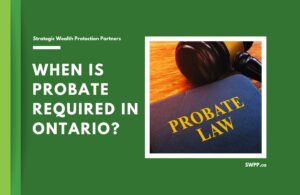Written by Ron Cooke, President & Founder of Strategic Wealth Protection Partners in Ontario, CEA®, Member of the Estate Planning Council Canada
What is a living trust in Canada?
A living trust is a legal arrangement where you transfer assets into a trust while you are still alive.
You choose a trustee to manage those assets according to the instructions you set out in the trust document. A living trust can help with estate planning by allowing your assets to be distributed without going through probate.

A living trust can also maintain privacy and make it easier to manage your affairs if you become ill or unable to handle things yourself.
In some cases, it may offer tax planning opportunities or help support family members with special needs.
Key Takeaways
- A trust can complement, but not replace, a will
- Living trusts help avoid probate and maintain privacy
- Trusts must be carefully structured to manage tax implications
- Not all assets are suitable to transfer into a trust
- The 21-year rule applies to inter vivos trusts in Canada
How Does a Living Trust Work in Canada?
A living trust in Canada is a legal arrangement created while you’re still alive to manage and protect your assets.
It involves transferring assets into the trust, which is a separate legal entity, and appointing a trustee to manage them. These trusts—called inter vivos trusts—can help bypass probate, reduce administrative delays, and provide privacy for your estate.
Because the assets are no longer in your personal name, the trust handles them according to the trust document, even if you become incapacitated. The tax implications of a living trust depend on its structure and how it’s used under the Income Tax Act.
How Do Living Trusts Differ from Wills and Testamentary Trusts?
Unlike a will, which only takes effect after death, a living trust operates during your lifetime and can continue after.
A testamentary trust is created through a will and becomes active only after your passing, meaning it must go through probate. Living trusts, particularly revocable living trusts, can offer more control and flexibility while you’re alive, including the ability to amend or dissolve them.
A will is a public document once probated, but living trusts offer privacy by keeping matters out of court. Probate fees, delays, and exposure are often reduced or avoided entirely with a properly established inter vivos trust.

When Does a Living Trust Make Sense in Canada?
A living trust can be an ideal estate planning tool when privacy, probate avoidance, or incapacity planning are priorities.
For high-value estates, it can provide a method of transferring assets without triggering unnecessary probate fees or delays. Families with vulnerable beneficiaries—such as minors or individuals with disabilities—often benefit from the continuity and oversight that a trust can provide.
Business owners or property investors may prefer the structure of a separate legal entity to keep operations smooth during transitions. An experienced estate planning lawyer can help assess whether the potential tax benefits justify creating a trust in your situation.
⭐ Related Read: A Quick Guide to Holding Property in a Trust in Ontario
What Are the Types of Living Trusts in Canada?
There are two main types of living trusts in Canada: revocable living trusts and irrevocable living trusts.
Each serves a different purpose and has different legal and tax implications, depending on the level of control and flexibility you need.
Revocable Living Trusts
A revocable living trust allows the settlor to maintain control over the assets and modify the trust as life circumstances change.
This flexibility makes it appealing for those who want ongoing oversight. However, because the assets are still considered yours for tax purposes, there are generally no immediate tax implications or potential tax benefits.
Irrevocable Living Trusts
An irrevocable living trust, by contrast, cannot be changed once established, and the assets placed in it are no longer considered part of your estate.
This structure can offer certain tax advantages if set up correctly, though it requires careful planning. The trust becomes a separate legal entity, and income generated may be taxed differently under the Income Tax Act.

What Assets Can Be Placed in a Living Trust?
A key part of setting up a living trust is deciding which assets to include.
While many types of assets can be transferred into a trust, some are better left out due to legal or tax implications.
Commonly Included Assets
Real estate, non-registered investments, bank accounts, shares in private corporations, and personal property are frequently added to trust assets. These assets can be smoothly managed by the trustee and distributed according to the trust document, often without probate.
Assets That May Not Be Suitable
Registered plans like RRSPs, RRIFs, and TFSAs often come with tax restrictions and beneficiary rules that don’t align easily with trust ownership. Similarly, jointly held property with rights of survivorship may bypass the trust entirely, making inclusion complex.
Who Should Be the Trustee of a Living Trust?
Choosing the right trustee is essential, as they hold the legal responsibility to manage the trust’s assets and follow the trust document faithfully.
The trustee must act in the best interest of the beneficiaries, ensuring financial decisions align with the trust’s purpose. You may appoint yourself initially (especially in a revocable living trust), but a successor trustee must also be named in case of incapacity or death.
In some cases, appointing a professional or corporate trustee brings experience and impartiality to complex estates. Always seek guidance from an experienced estate planning lawyer to ensure the trustee understands their obligations under Ontario law.

How to Set Up a Living Trust in Canada
Setting up a living trust in Canada involves a few key steps.
While the process can vary depending on your goals and the type of trust, the general structure is often similar. But before you start setting up a trust, speak with an estate planning expert in your province who can help you identify whether a trust is truly the right tool for you situation.
If you’re in Ontario, schedule a call with an SWPP estate planning expert HERE.
Here’s how the process typically works:
1. Decide what you want the trust to do
Before you create anything, think about your main goals.
Are you trying to avoid probate, protect assets for your children, or plan for incapacity? Knowing your purpose will help guide the setup process and determine the right type of trust.
2. Choose your trustee
The trustee is the person or institution responsible for managing the trust assets.
You can act as your own trustee while you are alive and capable, or you can choose someone else. It’s important to pick someone who is trustworthy, organized, and able to follow the terms of the trust.
3. Prepare the trust document
This legal document outlines the rules of the trust.
It names the trustee, the beneficiaries, and describes how the assets should be managed and distributed. You will usually work with a lawyer to make sure the document is properly drafted and reflects your wishes.
4. Transfer assets into the trust
Once the trust is created, you need to move assets into it.
This may involve changing the title of real estate, updating bank accounts, or assigning investments to the trust. If you don’t transfer the assets, the trust will not be effective.
5. Keep the trust up to date
As your life and financial situation change, you may need to update your trust.
This could involve adding new assets, changing beneficiaries, or updating your trustee. Staying on top of these changes helps keep your estate plan current and effective.
Setting up a living trust can offer peace of mind and more control over how your assets are managed, both during your lifetime and after. But it’s always a good idea to consult with an experienced estate planning lawyer to make sure everything is done properly.

What are the Benefits of a Living Trust?
A living trust—also known as an inter vivos trust—is more than just a legal tool.
For many families in Ontario, it becomes a form of quiet reassurance: a way to manage wealth, reduce stress, and maintain control when life becomes unpredictable.
Living trusts function as a separate legal entity, and with the right planning, they can help minimize probate fees, safeguard privacy, and bring peace of mind to both the person creating the trust and their loved ones. These estate planning tools aren’t just for the wealthy—they’re for anyone who wants to leave behind clarity instead of confusion.
Table: Benefits of a Living Trust
| Benefit | Why It Matters |
| Avoids probate | Your estate can be settled faster and more privately, without court involvement. |
| Maintains privacy, as it does not become a public record | Details about your assets and beneficiaries stay confidential. |
| Provides control over how and when assets are distributed | You can set specific instructions for timing and conditions of inheritance. |
| Helps manage assets if you become incapacitated | Ensures someone you trust can step in without requiring a court-appointed guardian. |
| May reduce legal disputes after death | Clear trust terms can reduce confusion and conflict among family members. |
| Can support special needs or blended family arrangements | Allows you to customize support for unique family dynamics or vulnerable heirs. |
What are the Disadvantages of a Living Trust?
While living trusts can be powerful, they’re not a fit for every situation.
There are plenty of disadvantages of living trusts. Establishing one takes thoughtful planning, legal precision, and a clear understanding of what can and cannot be included.
Some assets—especially registered accounts like RRSPs—have their own rules and tax implications under the Income Tax Act, which can limit how they interact with a trust. And without proper guidance from an experienced estate planning lawyer, even the best intentions can fall short.
It’s essential to weigh both the short-term effort and long-term benefits before deciding.
Table: Disadvantages of a Living Trust
| Drawback | Why It Matters |
| Can be expensive | Legal fees may be higher upfront, especially with custom terms. |
| Requires time and effort to transfer assets into the trust | If assets aren’t retitled properly, the trust may not control them. |
| Ongoing management may be needed during your lifetime | You may need to update or maintain the trust as your situation changes which also increases the costs involved. |
| Not all assets are easily transferred (e.g., RRSPs) | Some assets may still go through probate or be taxed differently. |
| May not offer significant tax advantages | Living trusts are generally tax-neutral under Canadian law. |
| Legal advice is usually needed to set it up properly | DIY approaches can lead to mistakes or make the trust invalid or ineffective. |
Key Tax and Legal Considerations for Living Trusts in Canada
A living trust is governed by complex rules under the Income Tax Act, especially when it comes to attribution rules and deemed dispositions every 21 years.
While it doesn’t usually result in direct tax benefits, it can help with orderly succession and planning around tax implications tied to specific trust assets. The trust itself is a separate legal entity, and income earned within it may be taxed at the highest marginal rate unless properly allocated to beneficiaries.
The trust document must clearly outline roles, responsibilities, and terms to meet legal requirements. Because of the intricacies involved—especially in transferring assets properly—it’s best to involve an experienced estate planning lawyer who understands the legal and practical considerations specific to Ontario.

Real Case Study: How a Family Trust Helped a Business Owner Protect His Growing Business and His Family’s Future
Background
John*, a 52-year-old business owner and long-time client in Ontario, had spent over two decades building a successful logistics company from the ground up.
As the business flourished and its value increased sharply, John became concerned about what would happen if something unexpected occurred and how he could eventually pass the business on to his children without eroding its value through estate taxes and probate fees.
Planning the Trust
After consulting with myself and his accountant, John chose to establish a family trust, legally known as an inter vivos trust.
He implemented a freeze and growth share structure, where his current shares were “frozen” at today’s value, and new growth shares were issued to the trust.
This meant that any future growth of the business would accrue to the trust, not to John personally. By transferring assets specifically, the new common shares into the trust, those shares were no longer part of his estate and would bypass probate entirely upon his death.
The trust’s assets were now held by a separate legal entity, offering both tax planning opportunities and legal continuity.
Tax and Family Benefits
This legal arrangement produced several potential tax benefits for John and his family:
- John limited the tax implications of a future sale or death by freezing the value that would otherwise trigger capital gains in his own hands.
- His adult children, named as beneficiaries, could benefit from income splitting, lowering the family’s overall tax burden.
- The trust structure allowed the family to multiply the Lifetime Capital Gains Exemption (LCGE) on a future sale of the business potentially shielding over $1 million per beneficiary from capital gains tax (if the shares qualified).
In addition to tax efficiency, the trust document included clear terms for how capital and income could be used whether for a child’s post-secondary education, supporting a new business venture, or helping a grandchild with special needs.
The trust was established as a revocable living trust during John’s lifetime, which meant he retained full control as trustee while achieving long-term estate planning objectives.
Looking Ahead
As John plans to eventually step back from his company, the succession plan is already in place.
The trust ensures that his business can pass to the next generation smoothly without the delays, costs, and legal challenges that often accompany estate transfers.
His legacy is protected, and his family is positioned to benefit for years to come.
*Names have been changed to protect the identity of SWPP’s client.

The 21-Year Rule: A Future Issue to Plan For
While a trust solves many immediate concerns, one important future consideration is the 21-year deemed disposition rule under the Income Tax Act.
This rule affects all inter vivos trusts, including family trusts holding shares of private corporations in Ontario.
What Is the 21-Year Rule?
Every 21 years, a trust is deemed to dispose of its capital property at fair market value, even if no actual sale takes place.
This creates a capital gains tax liability inside the trust unless proactive steps are taken.
If John’s family trust still holds the business shares at its 21st anniversary, the Canada Revenue Agency will treat those shares as if they were sold and will tax the accrued capital gain, potentially at the highest marginal rate.
Why It Matters in John’s Case
Because the trust was created to hold growing business shares, this rule could result in a significant tax bill.
Without careful planning, the trust might need to: pay tax at the top rate on the full unrealized gain, erode the business value, or even be forced to sell shares to fund the tax.
Managing the 21-Year Rule
There are established strategies to mitigate this future risk: roll assets out to the beneficiaries before the 21-year mark, on a tax-deferred basis (if allowed by the trust and if the beneficiaries are of age); sell the business before the 21st anniversary, allowing the family to claim the LCGE and plan for distribution; or use a corporate beneficiary or tax restructuring—with support from a tax advisor and estate planning lawyer—to delay or manage the exposure.

Common Questions
What are the disadvantages of a trust in Canada?
Trusts can be expensive to set up and require careful legal and tax planning. They also face the 21-year deemed disposition rule, which can trigger tax.
Is a living trust better than a will in Canada?
A living trust can help avoid probate and provide control while you’re alive. However, it doesn’t replace a will and isn’t right for everyone.
Can you put your house in a trust in Canada?
Yes, you can transfer your home into a trust, but it must be done properly to avoid unintended tax issues. Always review land transfer tax and principal residence exemption rules before doing so.
Does a living trust help you avoid the probate process?
Yes, assets held in a living trust typically avoid probate because they’re owned by the trust, not your estate. This can reduce delays, legal costs, and probate fees.
Discover the Benefits of a Living Trust in Ontario
Are you an Ontario resident considering a living trust as part of your estate planning?
At Strategic Wealth Protection Partners, we’re here to guide you through every step of the process with expert advice and personalized support. Begin your estate planning journey today with a Living Estate Plan Consultation from our experienced team.
Our mission at SWPP is to help you create an estate plan that secures your legacy, shields your assets from unnecessary taxation, and ensures your loved ones are cared for. By designing a living trust tailored to your goals, our experts will help you build a plan that truly reflects your values and priorities.
Take control of your future—start planning today!
Schedule a Living Estate Plan Consultation
Planning your legacy is about more than numbers—it’s about ensuring your family remembers you and your values are honoured for many years to come.
Estate planning and trusts can feel overwhelming, especially if it’s your first time. That’s why we’re here.
With our simple, 5-Step Living Estate Plan, we make the process easy, helping you create a comprehensive estate plan or trust that protects your assets from taxes and probate fees while preserving your legacy. Tools like The Final Word Journal capture your story, wishes, and essential details like accounts and end-of-life plans, ensuring your family has clarity and comfort.
Take the first step today—schedule a consultation call and give your family the ultimate gift: peace of mind and the assurance they were always your priority.
Read More
If you’re starting your estate planning process, you may find these articles helpful:
- Can I Put My House in a Living Trust in Canada?
- What Is the Best Trust to Avoid Probate in Canada?
- Living Trust Ontario Guide: What It Is & Do You Need One?
About the Author
RON COOKE, PRESIDENT & FOUNDER OF STRATEGIC WEALTH PROTECTION PARTNERS

With over 30 years in financial services, I’ve seen the challenges families face when a loved one passes—lost assets, unnecessary taxes, and emotional stress. That’s why I created the Living Estate Plan, a comprehensive process to protect assets, eliminate estate and probate fees, and create legacies that are remembered for many years to come.
This plan ensures your family receives not just your wealth, but a meaningful reminder of your care and love. Tools like The Final Word Journal capture your story, wishes, and essential details, offering clarity and comfort during difficult times.
Your final gift should be more than money—it should be peace of mind, cherished memories, and an organized estate.
Schedule a Call
Schedule a 30-minute consultation call with Strategic Wealth Protection Partners.
Click HERE to schedule a consultation.









